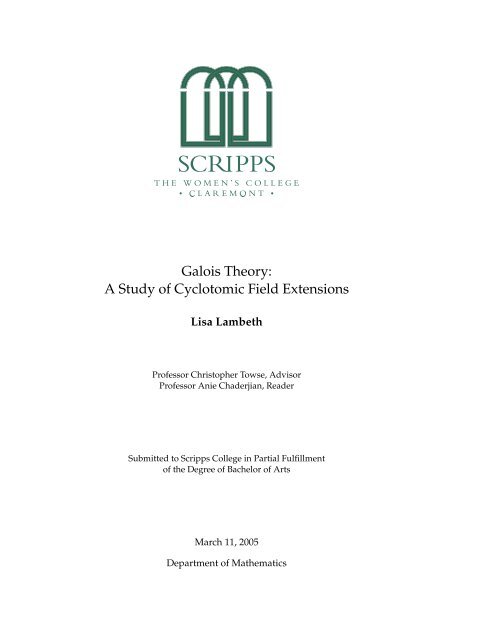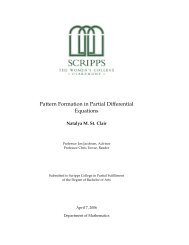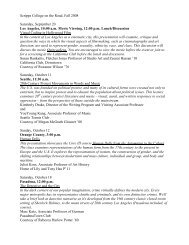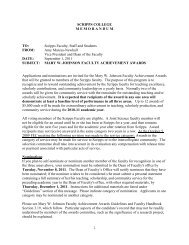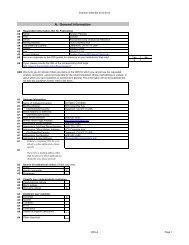Galois Theory: A Study of Cyclotomic Field ... - Scripps College
Galois Theory: A Study of Cyclotomic Field ... - Scripps College
Galois Theory: A Study of Cyclotomic Field ... - Scripps College
Create successful ePaper yourself
Turn your PDF publications into a flip-book with our unique Google optimized e-Paper software.
<strong>Galois</strong> <strong>Theory</strong>:<br />
A <strong>Study</strong> <strong>of</strong> <strong>Cyclotomic</strong> <strong>Field</strong> Extensions<br />
Lisa Lambeth<br />
Pr<strong>of</strong>essor Christopher Towse, Advisor<br />
Pr<strong>of</strong>essor Anie Chaderjian, Reader<br />
Submitted to <strong>Scripps</strong> <strong>College</strong> in Partial Fulfillment<br />
<strong>of</strong> the Degree <strong>of</strong> Bachelor <strong>of</strong> Arts<br />
March 11, 2005<br />
Department <strong>of</strong> Mathematics
Abstract<br />
This expository thesis explores the ideas <strong>of</strong> <strong>Galois</strong> theory. We begin with<br />
a basic overview <strong>of</strong> field theory before exploring the necessary aspects <strong>of</strong><br />
<strong>Galois</strong> theory needed to study cyclotomic field extensions. The cyclotomic<br />
field extensions studied in detail are Q(ζ 19 ) and Q(ζ 31 ).
Contents<br />
Abstract<br />
Acknowledgments<br />
iii<br />
xi<br />
1 Introduction 1<br />
2 The Basics <strong>of</strong> <strong>Field</strong> <strong>Theory</strong> 3<br />
2.1 <strong>Field</strong> Extensions . . . . . . . . . . . . . . . . . . . . . . . . . . 3<br />
2.2 Splitting <strong>Field</strong>s . . . . . . . . . . . . . . . . . . . . . . . . . . . 5<br />
3 <strong>Galois</strong> <strong>Theory</strong> 7<br />
3.1 Introduction . . . . . . . . . . . . . . . . . . . . . . . . . . . . 7<br />
3.2 The Main Theorem . . . . . . . . . . . . . . . . . . . . . . . . 11<br />
3.3 Pro<strong>of</strong> <strong>of</strong> the Main Theorem <strong>of</strong> <strong>Galois</strong> <strong>Theory</strong>. . . . . . . . . . 12<br />
3.4 Intermediate <strong>Galois</strong> Extensions . . . . . . . . . . . . . . . . . 14<br />
4 <strong>Cyclotomic</strong> <strong>Field</strong> Extensions 17<br />
4.1 Introduction . . . . . . . . . . . . . . . . . . . . . . . . . . . . 17<br />
4.2 Structure <strong>of</strong> the <strong>Galois</strong> Group . . . . . . . . . . . . . . . . . . 18<br />
4.3 Group Generators . . . . . . . . . . . . . . . . . . . . . . . . . 19<br />
4.4 Subgroups and Fixed <strong>Field</strong>s . . . . . . . . . . . . . . . . . . . 21<br />
4.5 Real Subfields and Quadratic Extensions . . . . . . . . . . . 24<br />
4.6 Statement <strong>of</strong> the Kronecker-Weber Theorem . . . . . . . . . . 31<br />
Bibliography 33
List <strong>of</strong> Figures<br />
4.1 Group Lattice for Q(ζ 19 ) . . . . . . . . . . . . . . . . . . . . . 21<br />
4.2 <strong>Field</strong> Lattice for Q(ζ 19 ) . . . . . . . . . . . . . . . . . . . . . . 24<br />
4.3 Simplified <strong>Field</strong> Lattice for Q(ζ 19 ) . . . . . . . . . . . . . . . . 29<br />
4.4 Group Lattice for Q(ζ 31 ) . . . . . . . . . . . . . . . . . . . . . 30<br />
4.5 <strong>Field</strong> Lattice for Q(ζ 31 ) . . . . . . . . . . . . . . . . . . . . . . 31
List <strong>of</strong> Tables<br />
4.1 <strong>Field</strong> Generator for Q(ζ 19 ) . . . . . . . . . . . . . . . . . . . . 20<br />
4.2 Subfield Generators . . . . . . . . . . . . . . . . . . . . . . . . 20
Acknowledgments<br />
I would first like to thank my advisor Pr<strong>of</strong>essor Christopher Towse for not<br />
only introducing me to to this beautiful field <strong>of</strong> mathematics but also for<br />
his enthusiasm and support throughout the entire project. I would also<br />
like to thank my second reader, Pr<strong>of</strong>essor Anie Chaderjian, for her support.<br />
My thesis would not have had such a great title page, awesome formatting,<br />
or beautiful figures were it not for Eric Malm. For all <strong>of</strong> your help with<br />
L A TEX issues, thank you. Finally, I want to thank my friends and family for<br />
supporting me as I wrote this thesis.
Chapter 1<br />
Introduction<br />
<strong>Galois</strong> theory is the study <strong>of</strong> the roots <strong>of</strong> the irreducible polynomial<br />
f(x) = x n + a n−1 x n−1 + · · · + a 1 x + a 0 .<br />
This is done by not limiting ourselves to finding roots that exist merely in<br />
the rational numbers, denoted Q. Rather, we instead allow ourselves to<br />
adjoin non-rational numbers to Q in order to find roots <strong>of</strong> polynomials. For<br />
example, we can adjoin √ −1 to Q to find the roots <strong>of</strong> x 2 + 1. Specifically,<br />
we will concentrate on what are known as cyclotomic field extensions <strong>of</strong> Q,<br />
which will be defined later in the text.<br />
Before we discuss <strong>Galois</strong> theory and look at cyclotomic field extensions,<br />
we will begin with some basic background information on fields.
Chapter 2<br />
The Basics <strong>of</strong> <strong>Field</strong> <strong>Theory</strong><br />
A field F is a commutative ring with identity in which every nonzero element<br />
has a multiplicative inverse. The set <strong>of</strong> nonzero elements <strong>of</strong> a field F ,<br />
denoted F × , is an abelian group under multiplication.<br />
An important property in field theory is the characteristic <strong>of</strong> a field. The<br />
characteristic <strong>of</strong> a field, if it exists, is the smallest positive integer p such<br />
that, if 1 F denotes the multiplicative identity element in our field F , then<br />
p · 1 F = 0. It is well known that such a p is a prime number. If no such p<br />
exists, we say the field has characteristic 0. The rationals, Q, is such a field.<br />
We shall concentrate on fields that have characteristic 0.<br />
2.1 <strong>Field</strong> Extensions<br />
Say that K is a field that contains F . Then K is an extension field <strong>of</strong> F . We<br />
denote this by K/F and read “K over F.” For example, R is an extension<br />
field <strong>of</strong> Q.
4 The Basics <strong>of</strong> <strong>Field</strong> <strong>Theory</strong><br />
Definition. An element α ∈ K is algebraic over F if α is a root <strong>of</strong> a nonzero<br />
polynomial f(x) ∈ F [x]. For example, √ 2 ∈ R is algebraic over Q since it is<br />
a root <strong>of</strong> x 2 − 2.<br />
Proposition 1. Let α be an algebraic element over the field F and f(x) be its<br />
irreducible polynomial <strong>of</strong> degree n. Then {1, α, . . . , α n−1 } is a basis for F [α] as a<br />
vector space over F .<br />
Pro<strong>of</strong>. See [A, p.495]<br />
The degree <strong>of</strong> a field extension K/F is the dimension <strong>of</strong> K as a vector<br />
space over F and is denoted [K : F ].<br />
A reason to study field extensions is to understand roots <strong>of</strong> polynomials.<br />
The polynomial x 2 + 1, for example, would not have any roots in R.<br />
However, the complex numbers C, would be a field extension <strong>of</strong> R (and<br />
thus an extension <strong>of</strong> Q) that would allow us to find roots <strong>of</strong> x 2 + 1. It is<br />
easy to show that C is a field under normal addition and multiplication, so<br />
every nonzero element in C has an inverse.<br />
We can consider a field K in which the polynomial f(x) has its roots.<br />
We will assume that the polynomial f(x) is irreducible over F [x] since if<br />
there is a root <strong>of</strong> a factor <strong>of</strong> f(x), then it would certainly be a root <strong>of</strong> f(x)<br />
itself.<br />
Let K be a field generated by a single element α over F . That is to say,<br />
every element β in K can be expressed as β = a 0 +a 1 α+a 2 α 2 +· · · a n α n for<br />
some n and some a 0 , a 1 , a 2 , . . . , a n ∈ F. Then we can write K = F (α). We<br />
say K is a simple extension <strong>of</strong> F and α is a primitive element for the extension.
Splitting <strong>Field</strong>s 5<br />
2.2 Splitting <strong>Field</strong>s<br />
Definition. If K is the extension field <strong>of</strong> a field F such that a polynomial<br />
f(x) ∈ F [x] factors completely into linear factors in K[x] (and f(x) does<br />
not factor into linear factors over any proper subfield <strong>of</strong> K that contains<br />
F ), then K is called the splitting field for f(x).<br />
Proposition. In any abstract splitting field for the polynomial x n − 1, the set<br />
<strong>of</strong> the nth roots <strong>of</strong> unity form a group under multiplication.<br />
Pro<strong>of</strong>. If α, β are both roots, α n β n = (αβ) n = 1, so the product αβ is<br />
in the set. Thus we have closure under multiplication. We know that 1<br />
is in our set since 1 n = 1. Given any root α, we can find a multiplicative<br />
inverse α −1 since (α) −1n<br />
= (α n ) −1 = 1 −1 = 1. We also have associativity<br />
because these roots are complex numbers. Thus we have a group under<br />
multiplication.<br />
□<br />
Definition. A primitive nth root <strong>of</strong> unity is a generator <strong>of</strong> the cyclic<br />
group <strong>of</strong> all nth roots <strong>of</strong> unity.<br />
We will denote the chosen primitive nth root <strong>of</strong> unity by ζ n . The other<br />
primitive nth roots <strong>of</strong> unity are then the elements ζn a where 1 ≤ a < n is<br />
an integer relatively prime to n, since these are the other generators for a<br />
cyclic group <strong>of</strong> order n. In particular there are precisely ϕ(n) primitive nth<br />
roots <strong>of</strong> unity, where ϕ(n) denotes the Euler ϕ-function.<br />
The splitting field <strong>of</strong> x n − 1 over Q is the field Q(ζ n ). The field Q(ζ n ) is<br />
called the cyclotomic field <strong>of</strong> nth roots <strong>of</strong> unity.
Chapter 3<br />
<strong>Galois</strong> <strong>Theory</strong><br />
3.1 Introduction<br />
<strong>Galois</strong> theory is the study <strong>of</strong> the roots <strong>of</strong> an irreducible polynomial<br />
f(x) = x n + a n−1 x n−1 + · · · + a 1 x + a 0 .<br />
We will study the symmetries between the roots <strong>of</strong> irreducible polynomials.<br />
A great deal can be understood from expanding the equation<br />
f(x) = (x − α 1 )(x − α 2 ) · · · (x − α n ).<br />
Comparing these two equations, we can see that the sum <strong>of</strong> the roots is<br />
α 1 + · · · + α n = −a n−1 and the product α 1 · · · α n = ±a 0 .<br />
Lagrange and <strong>Galois</strong> were the first mathematicians to see that the relationships<br />
between roots <strong>of</strong> polynomials could be understood in terms <strong>of</strong>
8 <strong>Galois</strong> <strong>Theory</strong><br />
symmetry [A, p.538]. Let us go back to our example <strong>of</strong> the polynomial<br />
x 2 + 1 = 0. We already know that our polynomial has no roots in Q, but it<br />
does have roots in C. Complex conjugation, the first model for the symmetric<br />
relationships we will be studying, gives us the roots ±i and leaves the<br />
rationals fixed. Any quadratic (degree 2) field extension will have similar<br />
symmetries.<br />
As an example, let us look at a degree 2 extension K/F generated by<br />
any α ∈ K which is not in F . Let f(x) = x 2 + bx + c be a polynomial with<br />
coefficients in F such that α is a root <strong>of</strong> f(x). We see that, b = −(α + α ′ ), so<br />
α ′ = −(α + b) is the other root. Over K, the polynomial f(x) splits into the<br />
linear factors (x − α)(x − α ′ ).<br />
Our symmetry comes from the fact that both α and α ′ are roots <strong>of</strong> f(x).<br />
Proposition 2. Let L = F (α) and L ′ = F (α ′ ) be two extension fields <strong>of</strong> F<br />
generated by the algebraic elements α and α ′ . Then there is an isomorphism <strong>of</strong><br />
fields<br />
σ : F (α) ˜→F (α ′ ),<br />
which is the identity on F and sends α → α ′ if and only if the irreducible polynomials<br />
for α and α ′ over F are equal.<br />
Pro<strong>of</strong>. See [A, p.496]<br />
According to the above proposition,<br />
σ : F (α) −→ F (α ′ )<br />
is an isomorphism which sends α → α ′ and is the identity on the field F .<br />
In our case, however, K can be generated by either <strong>of</strong> the two roots. That
Introduction 9<br />
is, L = L ′ = K. Thus, σ is an automorphism <strong>of</strong> K. Since σ is the identity<br />
map on F , b stays fixed (it is equal to −(α + α ′ )). Thus σ must send α to<br />
α ′ . We can conclude that σ 2 is the identity map on K since σ(α) = α ′ and<br />
σ(α ′ ) = α.<br />
Definition. Let K be an extension field. An automorphism <strong>of</strong> K which<br />
is the identity on F is an F-automorphism. It has the property that σ(a) = a<br />
for all a ∈ F . The F -automorphisms <strong>of</strong> K form a group under composition.<br />
The group <strong>of</strong> all F -automorphisms <strong>of</strong> the field extension K is known as the<br />
<strong>Galois</strong> group <strong>of</strong> K over F , denoted G(K/F ).<br />
Theorem 3. For any algebraic field extension K/F, the order <strong>of</strong> the <strong>Galois</strong><br />
group, |G(K/F )|, divides the degree <strong>of</strong> the extension [K : F ].<br />
Pro<strong>of</strong>. See [A, p.540]<br />
We know for any σ ∈ G(K/F ), any a in F will be fixed by σ, that is,<br />
σ(a) = a for all a in F . But a priori, there may be other elements <strong>of</strong> K fixed<br />
by σ.<br />
Definition. If the order <strong>of</strong> the <strong>Galois</strong> group is equal to the degree, then<br />
the field extension K/F is a <strong>Galois</strong> extension.<br />
Definition. The set <strong>of</strong> elements in a field K that are fixed by all the<br />
elements <strong>of</strong> G, a group <strong>of</strong> automorphisms <strong>of</strong> K is known as a fixed field <strong>of</strong><br />
G and is denoted K G .<br />
Corollary 4. Let K/F be a <strong>Galois</strong> extension. If its <strong>Galois</strong> group is G =<br />
G(K/F ), then F is the fixed field <strong>of</strong> G.<br />
Pro<strong>of</strong>. Let L be the fixed field, K G , <strong>of</strong> G. Clearly, F ⊂ L. Since F ⊂ L,<br />
every L-automorphism will also be an F -automorphism. This implies that<br />
G(K/L) is contained in G. However, every element in G is by definition <strong>of</strong>
10 <strong>Galois</strong> <strong>Theory</strong><br />
L an L-automorphism, which implies G(K/L) ⊃ G. We have containment<br />
in both directions, which means G = G(K/L). Since K/F was chosen to be<br />
a <strong>Galois</strong> extension, the order <strong>of</strong> G is equal to the degree <strong>of</strong> the extension K<br />
over F , or |G| = [K : F ]. If we now apply theorem 3, we know that the<br />
degree <strong>of</strong> the extension <strong>of</strong> K over L is divisible by the order <strong>of</strong> G. Since<br />
our original hypothesis was that F is contained in L, we are led to the<br />
conclusion that [K : F ] = [K : L], which implies F = L. Thus, F must also<br />
be a fixed field.<br />
□<br />
This corollary leads us into the following theorem relating fixed fields<br />
and splitting fields.<br />
Theorem 5. Let K be a splitting field <strong>of</strong> a polynomial f(x) whose coefficients<br />
are in the field F . Then K is a <strong>Galois</strong> extension <strong>of</strong> F . The reverse direction is also<br />
true; every <strong>Galois</strong> extension is a splitting field <strong>of</strong> some polynomial f(x) over F .<br />
Pro<strong>of</strong>. See [A, p.541]<br />
Corollary 6. Every finite field extension is contained in a <strong>Galois</strong> extension.<br />
Pro<strong>of</strong>. Let K/F be a finite extension. Suppose the generators <strong>of</strong> K over<br />
F are α 1 , . . . , α n . We need an irreducible polynomial for each α i over F ,<br />
call it f i (x). Let the product f 1 · · · f n be f. Then, let M be a field extension<br />
<strong>of</strong> K that is also a splitting field for f over K. This is done by adjoining any<br />
roots <strong>of</strong> some polynomial f i (x) to K if it was not already in K. If M is a<br />
splitting field for K, then it must also be a splitting field for F . By theorem<br />
5, M is a <strong>Galois</strong> extension. □<br />
Corollary 7. Let K/F be a <strong>Galois</strong> extension. Suppose L is an intermediate<br />
field F ⊂ L ⊂ K. Then K/L is also a <strong>Galois</strong> extension.<br />
Pro<strong>of</strong>. Let K be the splitting field <strong>of</strong> the polynomial f(x) over F . Since
The Main Theorem 11<br />
L ⊂ K, we know K is also a splitting field <strong>of</strong> f(x) over L. Then by theorem<br />
5, K is a <strong>Galois</strong> extension <strong>of</strong> L. □<br />
A critical part in the study <strong>of</strong> <strong>Galois</strong> theory is finding the intermediate<br />
fields L <strong>of</strong> an extension K/F . That is, such that F ⊂ L ⊂ K. We will be<br />
able to conclude from the Main Theorem <strong>of</strong> <strong>Galois</strong> theory that the intermediate<br />
fields <strong>of</strong> a <strong>Galois</strong> extension are in a bijective correspondence with the<br />
subgroups <strong>of</strong> the <strong>Galois</strong> group.<br />
3.2 The Main Theorem<br />
We will now return our attention to the Main Theorem <strong>of</strong> <strong>Galois</strong> <strong>Theory</strong>.<br />
Definition. Given an extension K/F , we will call any field L with F ⊂<br />
L ⊂ K an intermediate field.<br />
Theorem 8 (The Main Theorem <strong>of</strong> <strong>Galois</strong> <strong>Theory</strong>). If K is a <strong>Galois</strong> extension<br />
<strong>of</strong> a field F , and if G = G(K/F ) is its <strong>Galois</strong> group, then the function given<br />
by<br />
H ↦→ K H<br />
is a bijective map from the set <strong>of</strong> subgroups <strong>of</strong> G to the set <strong>of</strong> intermediate fields L.<br />
Its inverse function is defined by<br />
L ↦→ G(K/L).<br />
This corresponds to the property that if H = G(K/L), then [K : L] = |H|, hence<br />
the degree <strong>of</strong> the extension [L : F ] is equal to the index <strong>of</strong> the subgroup [G : H].
12 <strong>Galois</strong> <strong>Theory</strong><br />
Definition. Any two splitting fields K <strong>of</strong> a polynomial f(x) ∈ F [x] are<br />
isomorphic, so the <strong>Galois</strong> group G(K/F ) depends only on f up to isomorphism.<br />
It is called the <strong>Galois</strong> group <strong>of</strong> the polynomial over F .<br />
We are now almost ready to prove the Main Theorem <strong>of</strong> <strong>Galois</strong> theory.<br />
For convenience, the following corollary has been stated:<br />
Corollary 13. Let K/F be a algebraic field extension. The following properties<br />
are equivalent:<br />
(i) K is a <strong>Galois</strong> extension <strong>of</strong> F;<br />
(ii) K is the splitting field <strong>of</strong> an (irreducible) polynomial f(x) ∈ F [x];<br />
(iii) F is the fixed field for the action <strong>of</strong> the <strong>Galois</strong> group G(K/F ) on K;<br />
3.3 Pro<strong>of</strong> <strong>of</strong> the Main Theorem <strong>of</strong> <strong>Galois</strong> <strong>Theory</strong>.<br />
Pro<strong>of</strong> (<strong>of</strong> the Main Theorem). Let K/F be a <strong>Galois</strong> extension and L be an<br />
intermediate field. Let the corresponding subgroup <strong>of</strong> G be H = G(K/L).<br />
We know that H will act trivially on L, by definition. The intermediate field<br />
corresponding to a subgroup H <strong>of</strong> G(K/F ) is the fixed field K H <strong>of</strong> H. So,<br />
L is contained in K H .<br />
The following lemma assists us as the main counting argument in the<br />
pro<strong>of</strong> <strong>of</strong> the Main Theorem.<br />
Lemma 14. Let G be a group <strong>of</strong> automorphisms <strong>of</strong> a field K, and let the order<br />
<strong>of</strong> G be n. Then [K : K G ] = n.<br />
Pro<strong>of</strong>. [A. p. 554]
Pro<strong>of</strong> <strong>of</strong> the Main Theorem <strong>of</strong> <strong>Galois</strong> <strong>Theory</strong>. 13<br />
Since K/F is a <strong>Galois</strong> extension and F ⊂ L ⊂ K, the extension K/L is<br />
a <strong>Galois</strong> extension by Corollary 7. So, the degree <strong>of</strong> the extension [K : L] is<br />
equal to the order <strong>of</strong> H, denoted [K : L] = |H|. Using Lemma 14, we know<br />
that the order <strong>of</strong> H equals the degree <strong>of</strong> [K : K H ], or |H| = [K : K H ]. Since<br />
[K : L] = [K : K H ], and L ⊂ K H , we have L = K H .<br />
Now, suppose we start with H being a subgroup <strong>of</strong> G and we let L be<br />
the fixed field K H . Then H is a subgroup <strong>of</strong> G(K/L) since any element in<br />
H fixes L. That is, H ⊂ G(K/L). Now, the order <strong>of</strong> H is equal to the degree<br />
<strong>of</strong> the field extension from K H to K. But L = K H , so |H| = [K : K H ]. We<br />
know [K : L] is equal to |G(K/L)| since K/L is <strong>Galois</strong>. So we can conclude<br />
that [K : K H ] = [K : L] = |G(K/L)|. This gives us H = G(K/L).<br />
Now, we know that the two maps given by<br />
L ↦→ G(K/L) and H ↦→ K H<br />
are inverses. The Main Theorem <strong>of</strong> <strong>Galois</strong> <strong>Theory</strong>, as you may recall, stated<br />
that if K was a <strong>Galois</strong> extension <strong>of</strong> a field F , and G = G(K/F ) was its <strong>Galois</strong><br />
group, then there is a bijective map H ↦→ K H from the set <strong>of</strong> subgroups<br />
<strong>of</strong> G to the set <strong>of</strong> intermediate fields F ⊂ L ⊂ K. Further, its inverse function<br />
given by L ↦→ G(K/L). Further still, if H = G(K/L), then the degree<br />
<strong>of</strong> H is equal to [K : L], and [L : F ] = [G : H]. Since K/F was chosen to be<br />
a <strong>Galois</strong> extension <strong>of</strong> L, the degree <strong>of</strong> G is [K : F ]. Since |H| = [K : L] and<br />
[K : F ]/[K : L] = [L : K], with |G| being equal to [K : F ] and |H| equal<br />
to [K : L], we know [L : F ] = [G : H], and thus we have proved the Main<br />
Theorem <strong>of</strong> <strong>Galois</strong> <strong>Theory</strong>.<br />
□
14 <strong>Galois</strong> <strong>Theory</strong><br />
3.4 Intermediate <strong>Galois</strong> Extensions<br />
There are many important consequences <strong>of</strong> the relationship given by the<br />
Main Theorem <strong>of</strong> <strong>Galois</strong> theory. One concept is the idea <strong>of</strong> order reversing.<br />
That is to say, if L and L ′ are both intermediate fields and if the corresponding<br />
subgroups are H = (G/L) and H ′ = (K/L ′ ), then L ⊂ L ′ if and only if<br />
H ′ ⊂ H.<br />
Definition. Let L be an intermediate field. An F -automorphism σ <strong>of</strong> K<br />
will map L to some other intermediate field σL, which may or may not be<br />
the same as L. We define σL to be a conjugate subfield.<br />
Theorem 15. Let K/F be a <strong>Galois</strong> extension and L an intermediate field. Let<br />
H = G(K/L) be the corresponding subgroup <strong>of</strong> G = G(K/F ). Then we know<br />
the following are true:<br />
(a) Let σ ∈ G. The subgroup <strong>of</strong> G corresponding to the conjugate subfield<br />
σL is the conjugate subgroup σHσ −1 . That is to say, G(K/σL) =<br />
σHσ −1 .<br />
(b) L is a <strong>Galois</strong> extension <strong>of</strong> F if and only if H is a normal subgroup <strong>of</strong><br />
G. When H is a normal subgroup <strong>of</strong> G, then G(L/F ) is isomorphic to the<br />
quotient group G/H.<br />
Pro<strong>of</strong>. (a) Say that σL = L ′ and that τ ∈ H = G(K/L). Then στσ −1 ∈<br />
H ′ = G(K/L ′ ). To show this, we will need to prove that στσ −1 fixes any<br />
element in L ′ . Let α ′ ∈ L ′ . Then by definition, α ′ = σ(α) for some corresponding<br />
α ∈ L. Then στσ −1 (α ′ ) = στσ −1 (σ(α)) = στ(σ −1 )(σ)(α) =<br />
στ(α) = σ(α) = α ′ . Thus, στσ −1 fixes any element in L ′ . It follows that<br />
σHσ −1 ⊂ H ′ and, by symmetry with σ −1 and H −1 , we have σ −1 H ′ σ ⊂ H
Intermediate <strong>Galois</strong> Extensions 15<br />
if and only if H ′ ⊂ σHσ −1 , which gives us our equality H ′ = σHσ −1 .<br />
(b) ⇒ Suppose L/F is a <strong>Galois</strong> extension. Then L is a splitting field for<br />
some polynomial f(x) with coefficients in F . That is to say, L = F (β 1 , . . . , β n ),<br />
where the β i are roots <strong>of</strong> the polynomial f(x) in K. An F -automorphism σ<br />
<strong>of</strong> K permutes these roots and thus maps L to itself: σL = L. By (a) above,<br />
H = σHσ −1 . Thus, H is a normal subgroup.<br />
⇐ Let H be normal. Then for all σ ∈ G, we know H = σHσ −1 .<br />
So, G(K/L) = G(K/σL).<br />
This implies that for all σ, the composition<br />
σL = L. Every F -automorphism <strong>of</strong> K maps L to itself; it defines an F -<br />
automorphism <strong>of</strong> L by restriction. The restriction defines a homomorphism<br />
mapping G to G(L/F ), whose kernel is the set <strong>of</strong> all σ ∈ G which induces<br />
the identity on L, which we know to be H. We now can conclude that G/H<br />
is isomorphic to a subgroup <strong>of</strong> G(L/F ). We find that<br />
[L : F ] = |G/H| ≤ |G(L/F )|.<br />
Thus we can conclude that L is a <strong>Galois</strong> extension and G/H ≈ G(L/F ). □<br />
Definition. An extension K/F is an abelian extension if K/F is <strong>Galois</strong><br />
and the <strong>Galois</strong> group G(K/F ) is an abelian group.<br />
It is known that all subgroups <strong>of</strong> abelian groups are in fact normal subgroups.<br />
Further, we know all cyclic groups are abelian, but it is not necessarily<br />
true that all abelian groups are cyclic. We will now concentrate on<br />
extensions with cyclic <strong>Galois</strong> groups.
Chapter 4<br />
<strong>Cyclotomic</strong> <strong>Field</strong> Extensions<br />
4.1 Introduction<br />
Definition. Recall from Chapter 2 that for any n ∈ N, the nth cyclotomic field<br />
is a subfield K <strong>of</strong> the complex numbers generated over Q by ζ n = e 2πi/n .<br />
We will denote ζ n simply as ζ when no confusion will arise. A cyclotomic<br />
extension <strong>of</strong> Q is Q(ζ n ) and it is the splitting field <strong>of</strong> x n − 1. The roots <strong>of</strong><br />
the polynomial are the powers <strong>of</strong> ζ, the nth roots <strong>of</strong> unity: 1, ζ, ζ 2 , . . . , ζ n−1 .<br />
Here we will concentrate on the cases when n is a prime number p.<br />
We know that we can factor the polynomial<br />
x p − 1 = (x − p)(x p−1 + x p−2 + · · · + x + 1),<br />
and the polynomial (x p−1 + x p−2 + · · · + x + 1) is irreducible over Q, and<br />
ζ = ζ p is one <strong>of</strong> its roots; it is the irreducible polynomial for ζ over Q and<br />
the roots are powers <strong>of</strong> ζ, ζ 2 , . . . , and ζ p−1 . Thus the order <strong>of</strong> the <strong>Galois</strong>
18 <strong>Cyclotomic</strong> <strong>Field</strong> Extensions<br />
group G(Q(ζ)/Q) is p − 1.<br />
4.2 Structure <strong>of</strong> the <strong>Galois</strong> Group<br />
Theorem 16. Let p ∈ Z be prime and ζ = ζ p . Then the <strong>Galois</strong> group <strong>of</strong> Q(ζ) over<br />
Q is isomorphic to the multiplicative group (Z/pZ) × <strong>of</strong> nonzero elements <strong>of</strong> the<br />
ring Z/pZ and is a cyclic group <strong>of</strong> order p − 1.<br />
Pro<strong>of</strong>. Let G be the <strong>Galois</strong> group <strong>of</strong> Q(ζ) over Q. We will need a map<br />
v : G → (Z/pZ) × as follows: Let σ be an automorphism in G. Then σ will<br />
carry ζ to another root <strong>of</strong> the polynomial x p + · · · + x + 1, call it ζ i . Since<br />
ζ has multiplicative order p, our exponent i will be an integer modulo p.<br />
We set v(σ) = i. We need to verify that v is multiplicative. If τ is another<br />
element <strong>of</strong> G such that v(τ) = j, that is, τ(ζ) = ζ j , then<br />
στ(ζ) = σ(ζ j ) = σ(ζ) j = ζ ij = ζ ij .<br />
The identity automorphism will send ζ to ζ, so v(id) = 1. We know that<br />
v is a homomorphism to (Z/pZ) × since v is multiplicative and v(σ) does<br />
not equal 0 for any σ. The homomorphism is injective since ζ generates<br />
Q(ζ) and the action <strong>of</strong> an automorphism is determined when we know<br />
its action on ζ. Then we know G is isomorphic to its image in (Z/pZ) × .<br />
This means that G is cyclic. The order <strong>of</strong> G is equal to that <strong>of</strong> (Z/pZ) × , or<br />
|G| = |(Z/pZ) × |, which equals p − 1. These two groups are isomorphic. □<br />
Since (Z/pZ) × is a cyclic group, so is every subgroup. The <strong>Galois</strong> group<br />
G <strong>of</strong> K = Q(ζ p ) over Q is a cyclic group <strong>of</strong> order p − 1, we know G has one
Group Generators 19<br />
subgroup <strong>of</strong> order k for each k ∈ N which divides p − 1. If (p − 1)/k = r<br />
and if σ is the generator <strong>of</strong> G, then the subgroup <strong>of</strong> order k is generated<br />
by σ r . Applying the Main Theorem <strong>of</strong> <strong>Galois</strong> theory, we know there will be<br />
exactly one intermediate field L with [L : Q] = r. These fields are generated<br />
by certain sums <strong>of</strong> powers <strong>of</strong> ζ = ζ p .<br />
Example. Consider the case when p = 19 and ζ = ζ 19 . Then by the<br />
above theorem, we know that the <strong>Galois</strong> group <strong>of</strong> Q(ζ 19 ) is isomorphic to<br />
(Z/19Z) × and that it is a cyclic group <strong>of</strong> order 18, which we shall denote<br />
C 18 . Then, we know that the intermediate fields will correspond to the nontrivial<br />
divisors <strong>of</strong> 18, i.e. 2, 3, 6, and 9, and Q and Q(ζ 19 ) will correspond to<br />
the trivial divisors <strong>of</strong> 18, namely 1 and 18, respectively. The Main Theorem<br />
<strong>of</strong> <strong>Galois</strong> theory then tells us there will be exactly one intermediate subfield<br />
generated by each <strong>of</strong> these divisors.<br />
4.3 Group Generators<br />
A group is cyclic if there is an element a in G which generates G. That is,<br />
if there exists some a ∈ G such that G = {a n |n ∈ Z}. Let us concentrate<br />
on the G = (Z/19Z) × . Through trial and error, we can find the generators<br />
<strong>of</strong> this group and its subgroups. First, we must find the generator <strong>of</strong> the<br />
entire group. Table 4.1 illustrates one such choice <strong>of</strong> generator.<br />
We can see that every element is generated by a = 2 and the order is:<br />
a 18 , a 19 , a 13 , a 2 , a 16 , a 14 , a 6 , a 3 , a 8 , a 17 , a 12 , a 15 , a 5 , a 7 , a 11 , a 4 , a 10 , a 9 .<br />
Now that we know 2 is the generator <strong>of</strong> the entire group, we can find the<br />
generators <strong>of</strong> the intermediate subfields.
20 <strong>Cyclotomic</strong> <strong>Field</strong> Extensions<br />
a = 2 is a generator for G:<br />
a = 2 a 6 = 7 a 11 = 15 a 16 = 5<br />
a 2 = 4 a 7 = 14 a 12 = 11 a 17 = 10<br />
a 3 = 8 a 8 = 9 a 13 = 3 a 18 = 1<br />
a 4 = 16 a 9 = 18 a 14 = 6 a 19 = 2<br />
a 5 = 13 a 10 = 17 a 15 = 12<br />
Table 4.1: <strong>Field</strong> Generator for Q(ζ 19 )<br />
a 9 is a generator: a 6 is a generator: a 3 is a generator: a 4 is a generator:<br />
a 9 = 18 a 6 = 7 a 3 = 8 a 4 = 16<br />
a 18 = 1 a 12 = 11 a 6 = 7 a 8 = 9<br />
a 18 = 1 a 9 = 18 a 12 = 11<br />
a 12 = 11 a 16 = 5<br />
a 15 = 12 a 2 = 4<br />
a 18 = 1 a 6 = 7<br />
a 10 = 17<br />
a 14 = 6<br />
a 18 = 1<br />
Table 4.2: Subfield Generators<br />
Let us name the above subgroups as follows. Since a 9 a subgroup <strong>of</strong><br />
order 2, we will denote this subgroup <strong>of</strong> C 18 as C 2 . Similarly, a 6 generates<br />
a subgroup <strong>of</strong> order 3, denoted C 3 . Next, a 3 generates a subgroup <strong>of</strong> order<br />
6, so we will denote this subgroup C 6 . Finally, a 4 generates a subgroup <strong>of</strong><br />
order 9, so this subgroup will be denoted C 9 .<br />
The subgroups <strong>of</strong> the cyclic group C 18 correspond to H 2 , H 3 , H 6 , and<br />
H 9 , which are subgroups <strong>of</strong> the group G with powers <strong>of</strong> σ as generators.<br />
For example, C 2 = {e, a 9 } corresponds to H 2 = {id, σ 9 }.<br />
Figure 4.1 gives a lattice representation <strong>of</strong> the subgroups. The lines in-
Subgroups and Fixed <strong>Field</strong>s 21<br />
dicate containment. For example, the line connecting H 2 and H 6 represents<br />
[H 6 : H 3 ] = 3<br />
3<br />
{e}<br />
2<br />
H 3<br />
H 2<br />
3 2 3<br />
H 9<br />
2 3<br />
H 6<br />
G<br />
Figure 4.1: Group Lattice for Q(ζ 19 )<br />
4.4 Subgroups and Fixed <strong>Field</strong>s<br />
The intermediate fields are generated by sums <strong>of</strong> the powers <strong>of</strong> ζ = ζ 19 .<br />
We have found that a 3 yields a subgroup <strong>of</strong> order 6, a 4 one <strong>of</strong> order 9, a 6<br />
<strong>of</strong> order 3, and finally a 9 generates a subgroup <strong>of</strong> order 2. Thus our corresponding<br />
fixed fields will have degrees 6, 9, 3, and 2 over Q, respectively.<br />
We have found a = 2 to be a generator <strong>of</strong> (Z/19Z) × . This corresponds to<br />
σ ∈ G(Q(ζ 19 )/Q), where σ maps ζ to ζ 2 . We can now find generators in the<br />
field in terms <strong>of</strong> ζ 19 .<br />
We know that C 2 = {e, a 9 } corresponds to H 2 = {id, σ 9 }. Consider<br />
ζ + σ 9 ζ.
22 <strong>Cyclotomic</strong> <strong>Field</strong> Extensions<br />
Then<br />
σ 9 (ζ + σ 9 ζ) = σ 9 ζ + σ 18 ζ = σ 9 ζ + ζ.<br />
So<br />
ζ + σ 9 ζ = ζ + ζ 29 = ζ + ζ −1<br />
is fixed by all <strong>of</strong> H 2 . Thus, H 2 fixes Q(ζ + ζ −1 ). Since no other σ in G fixes<br />
ζ + ζ −1 , this is the fixed field <strong>of</strong> H 2 . That is, Q(ζ + ζ −1 ) is the fixed field <strong>of</strong><br />
H 2 .<br />
Next, consider the field H 3 which corresponds to C 3 = {e, a 6 , a 12 }. Since<br />
H 3 corresponds to C 3 , we know H 3 = {id, σ 6 , σ 12 }. Now we can consider<br />
ζ + σ 6 ζ + σ 12 ζ. We can check that every element in H 3 fixes ζ + σ 6 ζ + σ 12 ζ.<br />
First, we see σ 6 fixes every element.<br />
σ 6 (ζ + σ 6 ζ + σ 12 ζ) = σ 6 ζ + σ 12 ζ + σ 18 ζ = σ 6 ζ + σ 12 ζ + ζ.<br />
Then, we find that σ 12 also fixes every element.<br />
σ 12 (ζ + σ 6 ζ + σ 12 ζ) = σ 12 ζ + σ 18 ζ + σ 6 ζ = σ 12 ζ + ζ + σ 6 ζ.<br />
So this means ζ + σ 6 ζ + σ 12 ζ = ζ + ζ 26 + ζ 212 = ζ + ζ 7 + ζ 11 is fixed by all <strong>of</strong><br />
H 3 . Since no other σ in G will fix ζ + σ 6 ζ + σ 12 ζ, we know Q(ζ + ζ 7 + ζ 11 )<br />
is the fixed field <strong>of</strong> H 3 .<br />
Then we can look at H 6 , which corresponds to C 6 . The elements <strong>of</strong> H 6 =<br />
{id, σ 3 , σ 6 , σ 9 , σ 12 , σ 15 } fix all elements in ζ + σ 3 ζ + σ 6 ζ + σ 9 ζ + σ 12 ζ + σ 15 ζ.
Subgroups and Fixed <strong>Field</strong>s 23<br />
Then this means<br />
ζ + σ 3 ζ + σ 6 ζ + σ 9 ζ + σ 12 ζ + σ 15 ζ = ζ + ζ 23 + ζ 26 + ζ 29 + ζ 212 + ζ 215<br />
= ζ + ζ 8 + ζ 7 + ζ 18 + ζ 11 + ζ 12<br />
is fixed by all <strong>of</strong> H 6 and Q(ζ + ζ 8 + ζ 7 + ζ 18 + ζ 11 + ζ 12 ) is the fixed field<br />
<strong>of</strong> H 6 .<br />
Finally, we consider the corresponding field for C 9 , namely H 9 . The<br />
elements <strong>of</strong> H 9 = {id, σ 2 , σ 4 , σ 6 , σ 8 , σ 10 , σ 12 , σ 14 , σ 16 } fix all elements in<br />
ζ + σ 2 ζ + σ 4 ζ + σ 6 ζ + σ 8 ζ + σ 10 ζ + σ 12 ζ + σ 14 ζ + σ 16 ζ.<br />
This means<br />
ζ + σ 2 ζ + σ 4 ζ+σ 6 ζ + σ 8 ζ + σ 10 ζ + σ 12 ζ + σ 14 ζ + σ 16 ζ<br />
= ζ + ζ 22 + ζ 24 + ζ 26 + ζ 28 + ζ 210 + ζ 212 + ζ 214 + ζ 216<br />
= ζ + ζ 4 + ζ 16 + ζ 7 + ζ 9 + ζ 17 + ζ 11 + ζ 6 + ζ 5<br />
is fixed by all <strong>of</strong> H 9 . Again, no other σ in G fixes<br />
ζ + ζ 4 + ζ 16 + ζ 7 + ζ 9 + ζ 17 + ζ 11 + ζ 6 + ζ 5 ,<br />
so Q(ζ + ζ 4 + ζ 16 + ζ 7 + ζ 9 + ζ 17 + ζ 11 + ζ 6 + ζ 5 ) is the fixed field <strong>of</strong> H 9 .<br />
This can be more easily understood in the form <strong>of</strong> a field extension lattice.<br />
See Figure 4.2<br />
In the lattice representation <strong>of</strong> the field extension, we can clearly see the
24 <strong>Cyclotomic</strong> <strong>Field</strong> Extensions<br />
Q(ζ 19 )<br />
3<br />
2<br />
Q(ζ + ζ 7 + ζ 11 )<br />
Q(ζ + ζ −1 )<br />
3 2<br />
3<br />
Q(ζ + ζ 4 + ζ 5 + ζ 6 + ζ 7 + ζ 9 + ζ 11 + ζ 16 + ζ 17 )<br />
2<br />
Q(ζ + ζ 7 + ζ 8 + ζ 12 + ζ 18 )<br />
3<br />
Q<br />
Figure 4.2: <strong>Field</strong> Lattice for Q(ζ 19 )<br />
degree 2 and degree 3 extensions from Q to Q(ζ 19 ). Fortunately, this is not<br />
all that is known about the subfields. In the following section, we will get<br />
a better understanding <strong>of</strong> these two intermediate fields.<br />
4.5 Real Subfields and Quadratic Extensions<br />
Proposition 17. The subfield L max <strong>of</strong> K = Q(ζ p ) whose degree over Q is 1 2 (p−1)<br />
is generated over Q by the element η = ζ +ζ p−1 = 2 cos 2π/p. Moreover, L max =<br />
K ∩ R, so L max is called the maximal real subfield <strong>of</strong> K.<br />
Pro<strong>of</strong>. Consider the quadratic polynomial x 2 − ηx + 1, which has coefficients<br />
in Q(η) and η = ζ + ζ −1 . Note that ζ is a root. So we know that
Real Subfields and Quadratic Extensions 25<br />
[K : Q(ζ)] ≤ 2. Since η is a real number and ζ is not, Q(η) ⊂ K. So,<br />
[K : Q(η)] = 2, and Q(η) = K ∩ R. Thus, [Q(η) : Q] = 1 2<br />
(p − 1). □<br />
Thus in our example <strong>of</strong> Q(ζ 19 ), we can simplify our representation <strong>of</strong><br />
our real subfield <strong>of</strong> Q(ζ 19 ):<br />
( )<br />
However, if 2 cos 2π<br />
19<br />
( ( )) 2π<br />
Q(ζ + ζ −1 ) = Q 2 cos .<br />
19<br />
( )<br />
is in L max , then certainly cos 2π<br />
19<br />
will also be in the<br />
field. So we can simplify our representation <strong>of</strong> the real subfield further by<br />
( ( ))<br />
simply writing it as L max = Q cos 2π<br />
19<br />
. The maximal real subfield is just<br />
a degree 2 subfield <strong>of</strong> Q(ζ 19 ). In other words, [Q(ζ 19 ) : L max ] = 2.<br />
4.5.1 Discriminant <strong>of</strong> a Quadratic Extension<br />
Given any f(x) ∈ Q[x] and a splitting field K, we write f(x) = (x −<br />
α 1 ) · · · (x − α n ). Since K is a splitting field for f(x), all the roots <strong>of</strong> f(x)<br />
are going to be in K. Note that any σ ∈ G(K/Q) permutes these roots.<br />
Definition.<br />
The discriminant <strong>of</strong> a polynomial f(x) = (x − α 1 )(x −<br />
α 2 ) · · · (x − α n ) is defined to be<br />
D = (α 1 − α 2 ) 2 (α 1 − α 3 ) 2 · · · (α n−1 − α n ) 2<br />
= ∏ (α i − α j ) 2 = ± ∏ i − α j ).<br />
i
26 <strong>Cyclotomic</strong> <strong>Field</strong> Extensions<br />
Q contained in the cyclotomic field Q(ζ 19 ). Then<br />
L quad = Q( √ −19),<br />
where the sign was determined (−1) (p−1)/2 = (−1) 9 = −1.<br />
Pro<strong>of</strong>. We shall use the discriminant <strong>of</strong> the polynomial to find a generator<br />
for L quad . Let D be the discriminant <strong>of</strong> the polynomial<br />
x 19 − 1.<br />
This discriminant can be computed directly in terms <strong>of</strong> the roots {1, ζ, ζ 2 , . . . , ζ 18 },<br />
but the following lemma gives us a formula which is easier to use:<br />
Lemma 19. Let f(x) = (x − α 1 ) · · · (x − α n ). The discriminant <strong>of</strong> f is<br />
D = ±f ′ (α 1 ) · · · f ′ (α n ) = ± ∏ i<br />
f ′ (α i ),<br />
where f ′ is the derivative <strong>of</strong> f.<br />
Pro<strong>of</strong> <strong>of</strong> Lemma. By the product rule <strong>of</strong> differentiation,<br />
n∑<br />
f ′ (x) = (x − α 1 ) · · · (x − α i−1 )(x − α i+1 ) · · · (x − α n ).<br />
i=1<br />
Setting x = α i , we get<br />
f ′ (α i ) = (α i − α 1 ) · · · (α i − α i−1 )(α i − α i+1 ) · · · (α i − α n ). (4.1)<br />
i ≠ j.<br />
This is the product <strong>of</strong> the differences (α i − α j ), with the given i and
Real Subfields and Quadratic Extensions 27<br />
Thus,<br />
∏<br />
f ′ (α i ) = ∏ i − α j ) = ±D.<br />
i<br />
i≠j(α<br />
When we apply this lemma to the polynomial x 19 − 1, its derivative is<br />
19x 18 . The discriminant is given by<br />
□<br />
±D =<br />
18∏<br />
i=0<br />
19ζ i(18) = ζ N 19 19 ,<br />
where the exponent N is some integer. To determine ζ N , we note that ±D<br />
is a rational number, because x p − 1 ∈ Q[x] are rational. The reason D<br />
is rational is because it is in the splitting field K over Q. Because D was<br />
symmetrically defined, it is clearly in the fixed field <strong>of</strong> the whole <strong>Galois</strong><br />
group. That is, any Q-automorphism <strong>of</strong> K must permute the roots <strong>of</strong> f;<br />
any permutation <strong>of</strong> roots will fix D. However, the fixed field K G where G<br />
is the whole <strong>Galois</strong> group G(K/Q) is itself just Q. Thus, D is in Q. The only<br />
power <strong>of</strong> ζ which is rational is 1. So, ζ N = 1 and<br />
±D = 19 19 .<br />
The sign <strong>of</strong> the discriminant is determined to be negative by carefully<br />
comparing the definition <strong>of</strong> the derivitive and Equation 4.1. So the square<br />
root <strong>of</strong> this discriminant is δ = √ −19 19 . By definition <strong>of</strong> D, it is clear that δ<br />
in the field Q(ζ). Since the square factors can be pulled out <strong>of</strong> a square root,
28 <strong>Cyclotomic</strong> <strong>Field</strong> Extensions<br />
that is, √ −19 19 = 19 9√ −19, so we see<br />
Q(δ) = Q( √ −19).<br />
This gives us a quadratic subfield <strong>of</strong> Q(ζ). However, L is the only quadratic<br />
subfield, which means Q(δ) = L.<br />
□<br />
Note that the above theorem can be applied to any odd prime.<br />
Applying this theorem to Q(ζ 19 ), we can represent our unique quadratic<br />
extension <strong>of</strong> Q as:<br />
Q(ζ + ζ 4 + ζ 5 + ζ 6 + ζ 7 + ζ 9 + ζ 11 + ζ 16 + ζ 17 ) = Q( √ −19)<br />
Then if we re-visit our field lattice extension, we see<br />
Notice that L quad is not contained in L max . This corresponds to the fact<br />
that (p − 1)/2 is odd. Had it been even, then our discriminant D would<br />
have been a positive value, making δ real. Then, L quad would have to be a<br />
subfield <strong>of</strong> L max .<br />
The reader might have noticed that the prime 19 was <strong>of</strong> the form 19 =<br />
2·3 2 +1, or rather twice the square <strong>of</strong> a prime plus one. Let us now see how<br />
such a prime differs from a prime <strong>of</strong> the form 2 · p 1 · p 2 + 1, or twice two<br />
unique primes plus one. We will briefly explore the field extension Q(ζ 31 )<br />
over Q.<br />
Example. The subfields will correspond to the subgroups <strong>of</strong> (Z/31Z) × .<br />
The generator <strong>of</strong> this group is a = 3 and the generator for this cyclic group<br />
then the automorphism σ = σ 3 which maps ζ 31 to ζ31 3 . The subgroups <strong>of</strong> G
Real Subfields and Quadratic Extensions 29<br />
Q(ζ 19 )<br />
3<br />
2<br />
Q(ζ + ζ 7 + ζ 11 )<br />
( ( ))<br />
Q cos 2π<br />
19<br />
3 2<br />
3<br />
Q( √ −19)<br />
Q(ζ + ζ 7 + ζ 8 + ζ 12 + ζ 18 )<br />
2<br />
3<br />
Q<br />
Figure 4.3: Simplified <strong>Field</strong> Lattice for Q(ζ 19 )<br />
are<br />
H 2 = 〈σ 15 〉 = {1, σ 15 };<br />
H 3 = 〈σ 10 〉 = 〈σ 20 〉 = {1, σ 10 , σ 20 };<br />
H 5 = 〈σ 6 〉 = 〈σ 12 〉 = 〈σ 18 〉 = 〈σ 24 〉 = {1, σ 6 , σ 12 , σ 18 , σ 24 };<br />
H 6 = 〈σ 5 〉 = 〈σ 25 〉 = {1, σ 5 , σ 10 , σ 15 , σ 20 , σ 25 };<br />
H 10 = 〈σ 3 〉 = 〈σ 9 〉 = 〈σ 21 〉 = 〈σ 27 〉 = {1, σ 3 , σ 6 , σ 9 , σ 12 , σ 15 , σ 18 , σ 21 , σ 24 , σ 27 };<br />
H 15 = 〈σ 2 〉 = 〈σ 4 〉 = 〈σ 8 〉 = 〈σ 14 〉 = 〈σ 16 〉 = 〈σ 22 〉 = 〈σ 26 〉 = 〈σ 28 〉 =<br />
{1, σ 2 , σ 4 , σ 6 , σ 8 , σ 10 , σ 12 , σ 14 , σ 16 , σ 18 , σ 20 , σ 22 , σ 24 , σ 26 , σ 28 , }<br />
having orders 2, 3, 5, 10, and 15, respectively. The group lattice for Q(ζ 31 )<br />
would then be as shown in Figure 4.4. A degree 2 extension is represented<br />
with a red line, a degree 3 extension with a blue line, and a degree 5 exten-
30 <strong>Cyclotomic</strong> <strong>Field</strong> Extensions<br />
sion with a black line.<br />
{e}<br />
H 3 H 5 H 2<br />
H 15 H 6 H 10<br />
C 30<br />
Figure 4.4: Group Lattice for Q(ζ 31 )<br />
We then will go back and apply what we know about the real subfield<br />
and the unique quadratic extension to our lattice. The real subfield, ζ + ζ −1<br />
( )<br />
can be replaced by cos 2π<br />
31<br />
and the quadratic extension by Q( √ −31). Our<br />
field lattice is then shown in Figure 4.5. Once again, a degree 2 extension<br />
is represented with a red line, a degree 3 extension with a blue line, and a<br />
degree 5 extension with a black line.
Statement <strong>of</strong> the Kronecker-Weber Theorem 31<br />
Q(ζ 31 )<br />
( ( ))<br />
Q(ζ + ζ 5 + ζ 25 ) Q(ζ + ζ 2 + ζ 4 + ζ 8 + ζ 16 ) Q cos 2π<br />
31<br />
Q( √ −31)<br />
Q(ζ + ζ −1 + ζ 5<br />
+ζ 6 +ζ 25 +ζ 26 )<br />
Q(ζ + ζ −1 + ζ 2 + ζ 4 + ζ 8<br />
+ ζ 15 + ζ 16 + ζ 23 + ζ 27 + ζ 29 )<br />
Q<br />
Figure 4.5: <strong>Field</strong> Lattice for Q(ζ 31 )<br />
4.6 Statement <strong>of</strong> the Kronecker-Weber Theorem<br />
Recall at the end <strong>of</strong> Chapter 3, we defined an abelian extension K/F to be<br />
an extension whose <strong>Galois</strong> group G(K/F ) was an abelian group. Having<br />
studied the cyclotomic fields, we conclude with this surprising result.<br />
Theorem 20. Every <strong>Galois</strong> extension K <strong>of</strong> Q whose <strong>Galois</strong> group is<br />
abelian is contained in one <strong>of</strong> the cyclotomic fields Q(ζ n ).<br />
The pro<strong>of</strong> <strong>of</strong> this theorem is beyond the scope <strong>of</strong> this thesis, however, L.<br />
Washington presents a pro<strong>of</strong> in his book Introduction to <strong>Cyclotomic</strong> <strong>Field</strong>s.
Bibliography<br />
Artin, M. (1991). Algebra. Prentice-Hall, Inc., Upper Saddle River, New<br />
Jersey.<br />
Dummit, D. S. and Foote, R. M. (1991). Abstract Algebra. Prentice-Hall, Inc,<br />
Englewood Cliffs, New Jersey.<br />
Gallian, J. A. (2002). Contemporary Abstract Algebra. Houghton Mifflin Company,<br />
Boston, Massachusetts.<br />
Washington, L. C. (1982). Introduction to <strong>Cyclotomic</strong> <strong>Field</strong>s. Number 83 in<br />
Graduate Texts in Mathematics. Springer-Verlag, New York.


